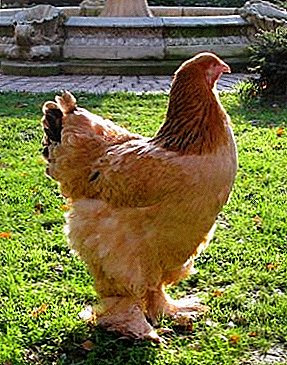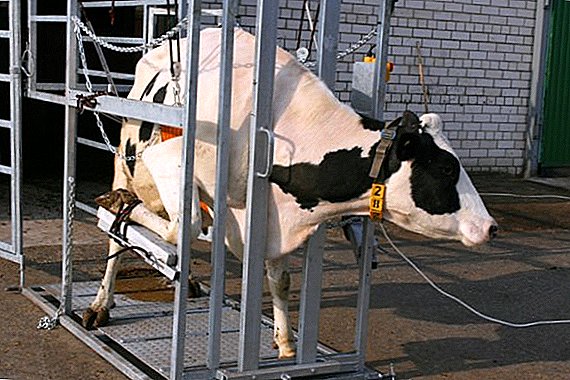 The most prominent part of the body in a rabbit is undoubtedly its ears, which are supposed to be adapted to the detection of predators. These important organs are not so rarely exposed to various dangerous diseases. It is important to know the symptoms of various sores that occur in the ears of rabbits in order to treat and understand them promptly and successfully.
The most prominent part of the body in a rabbit is undoubtedly its ears, which are supposed to be adapted to the detection of predators. These important organs are not so rarely exposed to various dangerous diseases. It is important to know the symptoms of various sores that occur in the ears of rabbits in order to treat and understand them promptly and successfully.
Myxomatosis
This disease affects all members of the order of lagomorphs, and rabbits as well. The causative agent of this disease is the virus Myxomatosis cuniculorum.
The carriers of the virus are blood-sucking parasites (bugs, mosquitoes, rabbit fleas), as well as rodents. The latent (incubation) period lasts from 7 to 18 days.
Did you know? In 1950, to reduce the population of Australian rabbits, the causative agent of myxomatosis was distributed among them. This led to the death of half a billion animals, but the remaining hundred million developed immunity to the disease. By the beginning of the 90s of the 20th century, their numbers had increased to approximately 300 million individuals.
Externally, myxomatosis is manifested in the form of subcutaneous solid tumors on the ears, head, in the area of the anus and the genitals of the animal. The skin on the head is collected in the folds, the mucous membranes of the eyes become inflamed, which is accompanied by sticking of the eyelids and purulent effusions. The ears of the animal hang over.  There are two forms of myxomatosis: edematous and nodular. When edematous form swelling occurs in the places of formation of tumors. The disease of the nodular form is accompanied by the appearance of small boils, which over time increase and open, releasing pus.
There are two forms of myxomatosis: edematous and nodular. When edematous form swelling occurs in the places of formation of tumors. The disease of the nodular form is accompanied by the appearance of small boils, which over time increase and open, releasing pus.
Important! The edematous type of myxomatosis lasts from 5 to 10 days (sometimes up to 25 days) and in 100% of cases leads to the death of the animal. The nodular form lasts 30–40 days, the mortality of rabbits can reach 70%.
Diagnose myxomatosis with the manifestation of clinical signs of the disease, as well as the results of laboratory studies.
When using effective antiviral drugs and treating nodular tumors with iodine, the mortality of rabbits from nodular myxomatosis can be reduced to 30%. At the same time, it is considered that in industrial farms the treatment of animals for this disease is generally inexpedient and ineffective.
Animals are simply euthanized, their carcasses are burned, the cells are disinfected.
Important! In an outbreak of myxomatosis, the veterinary service must be notified, which introduces a two-week quarantine.Vaccination of animals is used to prevent myxomatosis. The procedure is carried out when the rabbit is 45 days old. Pregnant rabbits are also vaccinated. In areas unfavorable for myxomatosis, three months after the first vaccination, they repeat the procedure.
Psoroptosis (ear mite)
Rabbit ears have many blood vessels, which makes them very attractive for parasites such as ear mites. These are small, 0.6 mm oval insects. Tick infestation is called psoroptosis, it requires treating a rabbit.
First, the tick appears on the inside of the ears, from there it can spread to the ear canal and the middle ear. The disease is transmitted by contact of infected animals with healthy ones.
The incubation period of psoroptosis lasts several days. Then the animals begin to show concern: rub their ears on a hard surface, try to scratch them with their paws.
Rabbits also often suffer from pasteurellosis and coccidiosis.From the bites of parasites appear wounds, emitting ichor, which, drying out, form scabs, and sulfur accumulates in the auricles.
The disease can lead to inflammation of the rabbit brain. Making sure that animals get exactly psoroptosis is pretty simple.  To do this, take a scraping from the rabbit ear and place it in vaseline oil heated to approximately +40 ° C. Ticks that appeared soon will be easy to see with a magnifying glass.
To do this, take a scraping from the rabbit ear and place it in vaseline oil heated to approximately +40 ° C. Ticks that appeared soon will be easy to see with a magnifying glass.
In the process of treating the disease, mites and scabs are removed. The wounds are smeared with a mixture in which one part of kerosene, glycerin (or vegetable oil) and creolin.
Too thick layers of scabs soften with a mixture of one part of iodine solution and four parts of glycerin.
Special sprays such as Psoroptol are also used. In case of mass diseases, drugs prescribed by a veterinarian are used. This may be, for example, drops of "Dekta" or injection solution "Baymek".
As a preventive measure recommended regular inspection of animals, cleaning their ears, as well as disinfection of enclosures. Newly arrived animals should be kept in quarantine for a couple of weeks.
After contact with diseased animals, wash hands thoroughly and disinfect clothes.
Frostbite
This disease occurs under the influence of low temperatures. First of all, the ears are affected, as well as the extremities of animals.
When the first degree of frostbite is observed swelling of the affected areas, the animal feels pain. When the second degree appears blisters, which burst and form ulcers.
The painful sensations intensify. At the third degree, the frostbitten tissues die off. All symptoms are easily detected by visual inspection.
For further treatment, the animal is primarily transferred to a warm place. If the first degree of frostbite is diagnosed, the affected area is smeared with goose or pork fat.  You can also use petroleum jelly or camphor ointment. At the second degree blisters are opened, the wounds are smeared with camphor or iodine ointment.
You can also use petroleum jelly or camphor ointment. At the second degree blisters are opened, the wounds are smeared with camphor or iodine ointment.
If it came to the third degree of frostbite, then, perhaps, you will need the help of a veterinarian, because the dead areas should be removed. Wounds that form during this process are treated as normal.
In order to avoid cases of frostbite, it is recommended to warm the cages for animals. To do this, use straw mats, which in the frosty days close the lattice walls of the enclosures.
In addition, straw is thrown inside the cells, in which rabbits can hide from the cold. The best way to avoid overcooling of animals is their maintenance in the winter in the warmed room.
Did you know? In ancient times, the rabbit symbolized life, fertility and profligacy. Often he was depicted along with the goddess Aphrodite.

Overheat
It is often asked: why does a rabbit have hot ears? The fact is that, mainly through the ears, the animal discharges excess heat from its body, thus struggling with overheating. But sometimes this natural cooling system does not help, and the animal can suffer from heat stroke.
Learn what to do with heat and sun strike in rabbits.Externally, overheating manifests itself initially in the form of the excited behavior of the animal - it is trying to find a place cooler. Later he falls into apathy and just falls to the floor.
The breathing of the animal accelerates and becomes abrupt, then it starts to breathe deeply, the body temperature rises, and convulsions of the limbs may appear. Ultimately, if you do not take action, all this can lead to his death.
All signs of overheating are easy to spot. You can duplicate the visual inspection by measuring the temperature of the animal - when overheated, it exceeds +40 ° C.
The maximum comfortable temperature of the air for a rabbit is +25 ° C, and at +35 ° C it is guaranteed and very quickly will get a heat stroke.  At the first symptoms, the animal needs to be moved to a shaded place, a cool compress from a damp cloth should be applied to the head and paws, which should be moistened with water at about + 15 ... +18 ° С every 5 minutes.
At the first symptoms, the animal needs to be moved to a shaded place, a cool compress from a damp cloth should be applied to the head and paws, which should be moistened with water at about + 15 ... +18 ° С every 5 minutes.
To prevent overheating, it is necessary to place the cells with rabbits in shaded ventilated places, but avoid drafts - they can cause pneumonia.
Animals provide fresh cool water that is regularly changed. Sometimes chilled water bottles wrapped in cloth are placed in the cells.
Otitis (inflammation)
This disease is mainly caused by various bacteria, such as Pasteurella multocida or Staphylococcus aureus. But sometimes the cause is a variety of fungi and yeast. The source of infection is located behind the eardrum.
As a result of inflammatory processes, fluid and pus accumulate there, the eardrum can even be destroyed.
Important! The infection can spread to both the outer and the inner ear and eventually lead to the death of the animal.
 Otitis is not good because at least in the initial stages it is very difficult to detect. In the future, the rabbit begins to behave as in psoroptes: shakes ears, scratches them with paws. When the eardrum is ruptured, you can notice a discharge in the ear.
Otitis is not good because at least in the initial stages it is very difficult to detect. In the future, the rabbit begins to behave as in psoroptes: shakes ears, scratches them with paws. When the eardrum is ruptured, you can notice a discharge in the ear.If the infection has spread to the inner ear, the animal begins to stumble on objects, spin in place, fall. At the same time his head is tilted, and his eyes rotate or continuously move horizontally.
Otitis is diagnosed by fluoroscopy. Cytological methods help identify the types of bacteria, fungi or yeast. It is clear that this can be done only in a veterinary clinic.
We advise you to get acquainted with different breeds of rabbits: white giant, gray giant, Californian, Angora, black-brown, butterfly, rizen, flandr, Soviet chinchilla.Treatment for otitis prescribes a veterinarian. It determines which drugs can be used in this case. Apply antibacterial drops or antibiotics. If no improvement is observed within two weeks, the drugs change.
Otitis development depends on the overall condition of the rabbit's immune system. Healthy animals can carry bacteria and not get sick.  So, rabbit ears can be affected by diseases that even lead to the death of these animals. Not always such diseases can be cured, but proper and timely preventive measures, as well as their maintenance, will help to minimize the risk of diseases.
So, rabbit ears can be affected by diseases that even lead to the death of these animals. Not always such diseases can be cured, but proper and timely preventive measures, as well as their maintenance, will help to minimize the risk of diseases.












